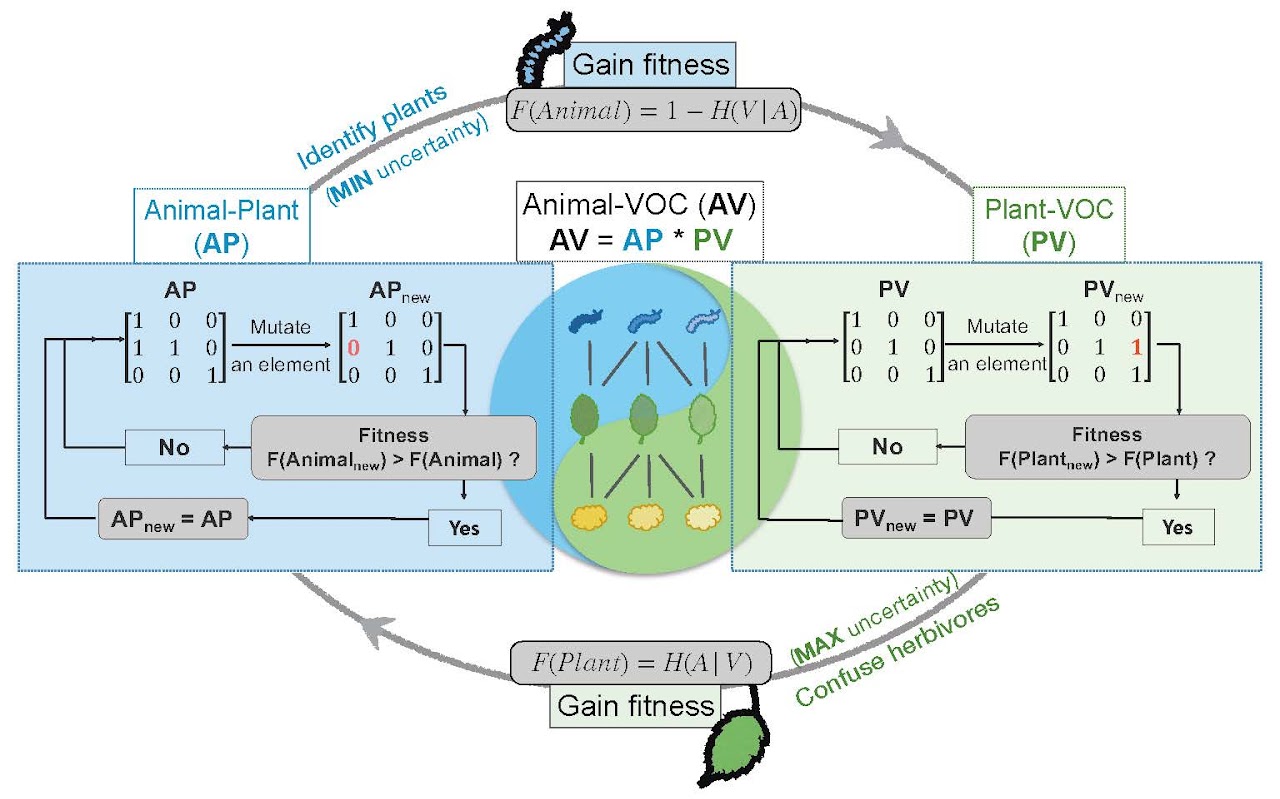Publications
Paper highlight

Information arms race explains plant-herbivore chemical communication in ecological communities
Zu P*, Del-Val E, Boege K, Schuman M, Stevenson P, Alejandro Zaldivar-Riveron, Saavedra S. 2020 Science
DOI: 10.1126/science.aba2965
Abstract:
Plants emit an extraordinary diversity of chemicals, providing information about their identity and mediating interactions with insects. However, most studies have focused on a few model species in controlled environments, limiting our capacity to understand plant-insect chemical communication in ecological communities. Here, by integrating information theory with ecological and evolutionary theories, we show that a stable information structure of plant volatile organic compounds (VOCs) can emerge from a conflicting information process between plants and herbivores. We corroborate this information arms-race theory with field data recording plant-VOC associations and herbivore-plant interactions in a tropical dry forest. We reveal that plant VOC redundancy and herbivore specialization can be explained by a conflicting information transfer. Information-based communication approaches can increase our understanding of species interactions across trophic levels.
<Full paper> <Perspective by Ricard Solé> <Science>
Peer Reviewed Papers
2023
Zu, P., Zhang, D.Y. and Luo, Y.B., 2023. Chemical communication between plants and insects. *Journal of Systematics and Evolution, 61(3), 441-444. link
Warrit, N., Ascher, J., Basu, P.,… & Zu, P., Orr, M., 2023. Opportunities and challenges in Asian bee research and conservation. *Biological Conservation, 110173. link
2022
Zu, P., Garcia-Garcia, R., Schuman, M., Saavedra, S. and Melian, C. 2022. Plant-insect chemical communication in ecological communities: an information theory perspective. *Journal of Systematics and Evolution. link
Schwery, O., Sipley, B., Braga, M. P., Yang, Y., Rebollo, R., & Zu, P.*. 2022. Plant Scent and Plant‐Insect Interactions–Review and Outlook from a Macroevolutionary Perspective. *Journal of Systematics and Evolution. link
Saavedra, S., Bartomeus, I., Godoy, O., Rohr, R.P. and Zu, P. 2022. Towards a system-level causative knowledge of pollinator communities. *Philosophical Transactions of the Royal Society B 377(1853). link
2021
JX. Fang, HC. Du, X. Shi, SF. Zhang, F. Liu, Z. Zhang, P. Zu, and XB. Kong. 2021. Monoterpenoid signals and their transcriptional responses to feeding and juvenile hormone regulations in bark beetle Ips hauseri Reitter. Journal of Experimental Biology 224(9):jeb238030 link
Zu, P., Koch, H., Schwery, O., Pironon, S., Phillips, C., Ondo, I., Farrell, I., Nes, W.D., Moore, E., Wright, G., Farman, D.I., and Stevenson PC. 2021. Pollen sterols are associated with phylogeny and environment but not with pollinator guilds. New Phytologist link
2020
Zu P*, Del-Val E, Boege K, Schuman M, Stevenson P, Alejandro Zaldivar-Riveron, Saavedra S. 2020. Information arms race explains plant-herbivore chemical communication in ecological communities. Science. link
Zu P, Schiestl FP, Li X, Runcie DE, Gervasi D, Guillaume F. 2020. Floral signals evolve in a predictable way under artificial and pollinator selection in Brassica rapa. *BMC Evolutionary Biology 20(1), 1-12. link
Before 2020
Zu P*, Schiestl FP. 2017. The effects of becoming taller: Direct and pleiotropic effects of artificial selection on plant height in Brassica rapa. The Plant Journal 89, 1009-1019. link
Zu P, Blanckenhorn WU, Schiestl FP. 2016. Heritability of floral volatiles and pleiotropic responses to artificial selection in Brassica rapa. *New Phytologist 209(3): 1208-1219. link
Cai J, Zu P, Schiestl FP. 2016. The molecular bases of floral scent evolution under artificial selection: insights from a transcriptome analysis in Brassica rapa. *Scientific Reports 6: 36966. link
Sletvold N, Grindeland JM, Zu P, Ågren J. 2012. Strong inbreeding depression and local outbreeding depression in the rewarding orchid Gymnadenia conopsea. *Conservation Genetics 13(5): 1305-1315. link
